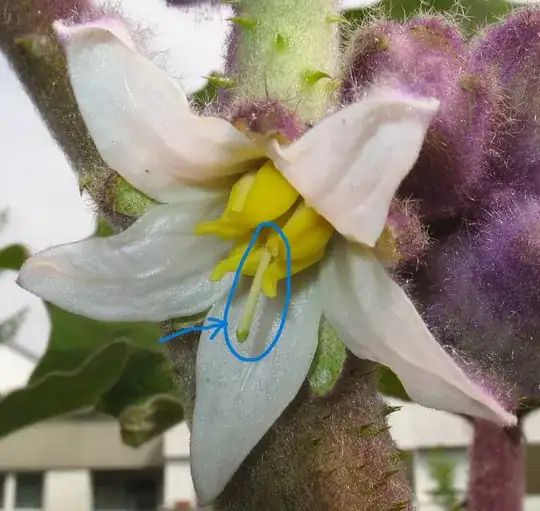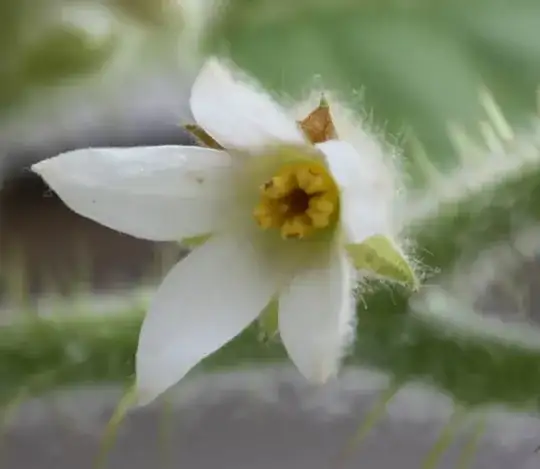How can I tell which flowers of my niranjillas are female? I thought they were self pollinating but someone suggested I may not be pollinating female ones. I can’t see any bulbous bases to any flowers to indicate they are female. I have been trying to pollinate them using a vibrating bee. (The plants are in my home.)
-
Hi, I described how the male and female (i.e., hermaphrodite) flowers look in the answer below using images available on the web. If you could upload images of your naranjilla flowers, it would have been possible to indicate which one is male and which one female. – joy Feb 14 '22 at 20:33
2 Answers
The male flower (functionally male, cannot produce fruit) and the female flower (hermaphrodite, can produce fruit and can be self-pollinated) of naranjilla can be distinguished by the length of the styles of their respective pistils.
Naranjilla plants are strongly andromonoecious (means the plant has both male and hermaphrodite flowers) (Miller and Diggle 2003; Messinger et al. 2016). How to distinguish a male flower from a hermaphrodite flower in naranjillas? As described in Messinger et al. 2016:
the inflorescences consist of hermaphrodite flowers with long styles and large ovaries, and functionally male flowers, which have short styles and never set fruit (Diggle and Miller 2004; Almanza Fandiño 2007).
The following is a picture of a hermaphrodite naranjilla flower (Attribution: Digital Camera, CC BY-SA 3.0 https://creativecommons.org/licenses/by-sa/3.0, via Wikimedia Commons):
See the hanging pistil with long style? This indicates a hermaphrodite flower. The (functionally) male flowers would not have such a prominent long style, as depicted in the following picture (Attribution: I.Sáček, senior, Public domain, via Wikimedia Commons):
For description of flower parts, this image is illustrative.
The particular morphology of the naranjilla flower requires specialized pollination process. Again from Messinger et al. 2016:
The pollen is enclosed in the anthers and can only be released via two apical pores per anther. As in many Solanum species, this is facilitated in S. quitoense by rapid bumblebee-produced vibrations during so-called 'buzz pollination' (Buchmann 1983; Almanza Fandiño 2007) or 'sonication’ (Buchmann and Cane 1989).
Hermaphrodite flowers can be self-pollinated. However, as noted in Messinger et al. 2016, self-pollination give 25% fewer fruit set compared with cross-pollination by hand.
References:
Buchmann S. L. (1983). Buzz pollination in angiosperms. In: Handbook of experimental pollination biology. Ed. by Jones, C. E., Little, R. J., Scientific and Academic Editions, New York, 73–113.
Buchmann, S. L., & Cane, J. H. (1989). Bees assess pollen returns while sonicating Solanum flowers. Oecologia, 81(3), 289-294. [link]
Diggle, P. K., & Miller, J. S. (2004). Architectural effects mimic floral sexual dimorphism in Solanum (Solanaceae). American Journal of Botany, 91(12), 2030-2040. [link]
Almanza Fandiño, M. T. (2007). Management of Bombus atratus bumblebees to pollinate lulo (Solanum quitoense L), a native fruit from the Andes of Colombia (Vol. 50). Cuvillier Verlag. [preview link]
Messinger, J., Martini, M. M. F., Rossi, G., Samuels, J., & Lauerer, M. (2016). Successful pollination of the N eotropical crop S olanum quitoense by B ombus terrestris: behaviour, efficiency and yield. Journal of Applied Entomology, 140(1-2), 124-134. [link]
Miller, J. S., & Diggle, P. K. (2003). Diversification of andromonoecy in Solanum section Lasiocarpa (Solanaceae): the roles of phenotypic plasticity and architecture. American Journal of Botany, 90(5), 707-715. [link]
- 687
- 2
- 4
- 14
Narajilla is in the Solanum genus (Solanum quitoense) and is monoecious, which means that there are no male and female flowering plants - all flowers are capable of setting fruit if pollinated, just like its relative the tomato.
According to this site, the plant can be self-fertile or bee-pollinated:
All Solanum species have poricidally dehiscent anthers that result in buzz pollination syndrome, where pollen can only be released by particular bee species. This pollination syndrome can be found in about 200 genera of flowering plants (Buchmann, 1983). Naranjilla flowers are hermaphrodite and can be self-fertile (Martin et al., 1987) or show allogamy, depending on insects for pollination. Flowers can have short, medium or long styles, and the last two types can be cross-pollinated. Pollination is performed by insects such as honey-bees and bumblebees (Paull and Duarte, 2012).
The "style" mentioned above is part of the flower's female anatomy. See this page from the University of Illinois for an illustration. You may be able to find the medium and long style flowers on your plant to help ensure better odds at pollination.
- 18,009
- 1
- 15
- 36

